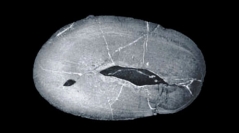

 Comptes Rendus Palevol
13 (6) - Pages 501-509
Comptes Rendus Palevol
13 (6) - Pages 501-509The Early Eocene deposits of El Kohol, Algeria, have yielded numerous remains of Numidotherium koholense, one of the most primitive and oldest known proboscideans in Africa. The Upper Eocene proboscideans of the Fayum locality (Egypt), Barytherium sp. and Moeritherium sp., were recently interpreted as aquatic or semi-aquatic, according to the stable isotopic compositions (δ13C and δ18O) of their tooth enamel. These data led us to reinvestigate the adaptations of N. koholense. Stable isotopic analysis and observations of histological sections of its long bones reveal that it was essentially terrestrial. According to its position within the phylogenetic tree of Eocene proboscideans, the adaptation to semi-aquatic life appears to have evolved independently in different lineages of Middle and Upper Eocene proboscideans during their adaptive radiation in Africa. Moreover, these new results reopen the debate about the hypothesis that Eocene to Recent proboscideans are derived from semi-aquatic ancestors.
Numidotherium koholense, Eocene, Algeria, Terrestrial life, Stable isotopes, Histology